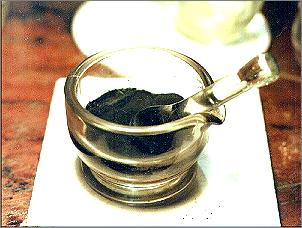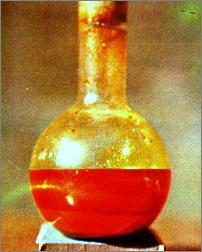Ethiop Mineral
We know that some alchemists have difficulty in
finding native cinnabar for their alchemic and spagyric experiences.
It is not easy to find a pure cinnabar that
guarantees us a minimum of impurities and the best that we know of is imported from China
in magnificent crystals but also, very expensive. Therefore, we will have to be satisfied
with the one of Almaden (Spain) and of other places. The best that we got had more than 50
per cent of silica.
But for experimental purpose you can easily get
an excellent artificial cinnabar by two different ways: the dry and the humid way.
Dry way
On a gas stove and in a tureen of refractory mud
or of sandstone, pour 2 ounces of grinded brimstone. As soon as this is in fusion, pour 7
ounces of commercial mercury the purest possible, and passed by the suede. When squeezed,
it comes out in rain form.
Mix the melted sulphur continually until that the
mercury is well incorporate. Let to cool the matter, which will be black and place its
rough powder to sublimate in a pot of refractory mud or sand stone, which is an aludel
that has a small air hole at the top.
Place the aludel on a gas stove to heat up until
the bottom of the aludel is red-hot. The cinnabar will sublimate little by little in the
aludel heat, in beautiful red crystals as needles. Remove it off the lid of the aludel and
keep it in a large mouth glass flask under the shelter of the light. It is an artificial
cinnabar and it is not a live matter because it already "felt" the common fire.
But for experimentation purpose it will be very useful.
Be careful not breath the gases that emanates
from the air hole of the aludel because they are extremely toxic.
Wet way
In a Pyrex glass mortar, pour 70g of native quick
silver preferably of "flowing", (the mercury that is from the cinnabar mines)
and 30g of native brimstone. Grind the composition slowly the necessary time in way to
incorporate the quick silver completely in the sulphur. The compositions after being well
grind and mixed, will be of a black colour and it is known in spagyria by Ethiopian
Mineral. Chemically it is an artificial mercury sulphide.

Pour the composition into a 500ml good Pyrex
glass matrass with a rubber stopper and, above it, pour a solution of 30g of caustic
potash (potassium hydroxide) made with rainwater or deliquesced during the night. Close
the matrass well and place it on a small electric oven or on a gas stove in bath of sand
to a temperature that doesn't surpass the 60°C.
Leave for some hours and the Ethiopian will begin
to turn red starting from the bottom of the matrass until the colour dye's completely
the whole mass of the composition.

When the composition is all red, remove the
matrass of the oven, let it cool and pour rainwater inside. Move well with a glass rod and
spill everything in a 1-litre large mouth glass flask. Pour more water into the flask to
wash the cinnabar of any salinity. By decantation, spill with care all of the water. The
cinnabar being very heavy will stay at the bottom of the flask. Dry it to a moderate
temperature that doesn't surpass the 60°C and it will be ready to used.
The cinnabar if it was prepared with natural
matters as the "flowing mercury", the native sulphur and the salt to unite it in
the Natural proportions, then it can be used for alchemic works.
When the preparation of the artificial cinnabar
is done by the wet way, a red liquid remains which is the salt that changed by having
dissolved the excess of sulphur. It will have a nauseous smell of sulphydric gas and it is
very toxic, but it is also a medicine that will only be taken in homeopathic doses and
always under a doctor of the speciality required.
We made this preparation several times but
without knowing the reason why we didn't get the Ethiope completely red which could be,
for a technical explanation, because the proportions of the salt were not right or the
temperature was inadequate.
This was the old vermilion used by the ancient
painters in the oil painting but it has the inconvenience of being very sensitive to the
light and will turn black or darker just as it happens with the native cinnabar.
Rubellus Petrinus